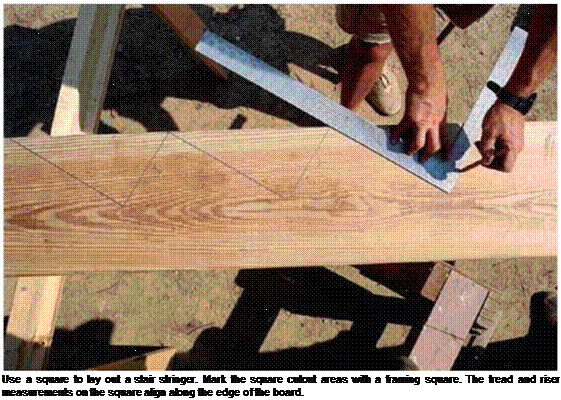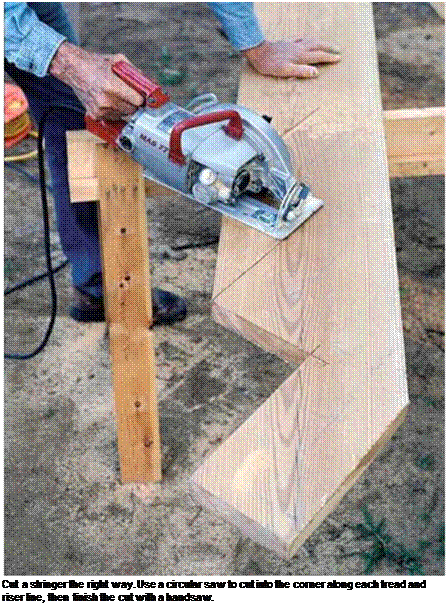Lay out and cut the stringers
There are two basic types of stringers for stairs. Cut, or open, stringers have square cutouts to support treads and risers. Closed stringers use cleats rather than cutouts to support treads. To
 |
give a deck or porch stairway a trim look, I like to use closed stringers on the sides. Cut stringers must be used in the middle. Stringers for outdoor stairways are usually cut from PT 2x12s. Stairs with three risers can be cut from 4-ft. stock, but it’s a bit tight. Stairs with four risers can be cut from 6-ft. stock.
A framing square and a pencil are all you need to lay out stair stringers. Although they aren’t necessary, a pair of stair gauges (small clamps that screw onto a framing square) make the layout process faster and just about foolproof. Attach one gauge at the 71/2-in. measure (the rise) on the narrow part of a framing square (the tongue). Place the other gauge at the 11-in. measure (the tread width) on the wider part of the square (the blade). Now lay out the stringer, working from the bottom to the top. If you don’t use stair gauges on a framing square, simply align the 71/2-in. and 11-in. measurements over the edge of the stringer, as shown in the photo above. After marking the first tread and riser, move the square up,
place the tread mark directly on the riser mark, scribe the second tread and riser, then do the third. Then use the square to mark a level cut at the bottom of the stringer and a plumb cut at the top.
The bottom of the stringer must be “dropped” to allow for the thickness of the first tread. If you were to screw a FA-in.-thick tread on the first riser (7’/2 in. tall), then the first step would be 9 in., which would cause a lot of people to trip every time they used the stairs.
To make each riser the same height, cut 1’/2 in. from the bottom of the stringer. Finish laying out this stringer by marking a notch for a 2x 4 kicker board. It’s best to cut the kicker-board notch at the back of the stringer.
When the layout is complete, it’s time to cut the stringer. Start the cuts with a circular saw, closely following the lines (see the top photo on p. 188). Then use a handsaw or a jigsaw to finish the cuts at the intersection of the tread and the riser so that you don’t overcut and weaken the stringer.
 A CUT STRINGER SERVES AS A PATTERN FOR A CLOSED STRINGER.
A CUT STRINGER SERVES AS A PATTERN FOR A CLOSED STRINGER.
Once you’ve completed a cut stringer, use it as a pattern for other cut and closed stringers in the same staircase (see the photo at right). The plumb and level cuts at the top and bottom of the closed stringer are identical to those on the cut stringer, but they are the only cuts you need to make on a closed stringer. Using the cut stringer as a pattern, mark the tread lines on the closed stringer to indicate where the cleats must be installed.
Fasten F/2-in.-sq. PT wood cleats below the tread lines on each closed stringer (see the top photo on the facing page). Drive four 21/2-in.-long deck screws to secure each cleat. Manufactured metal cleats are also available, if you prefer. The treads will be screwed to the cleats after all the stair stringers have been installed.






Leave a reply